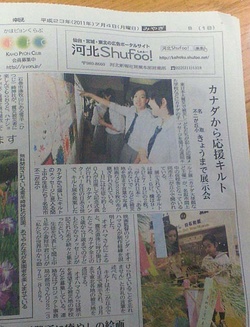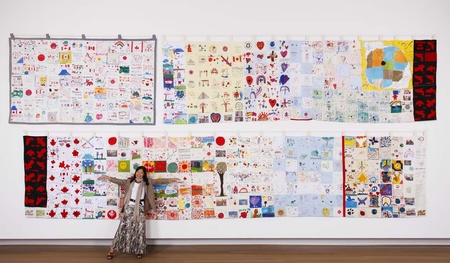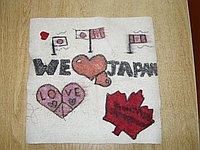I am very proud to say that my friend film maker/poet/artist Linda Ohama of Vancouver has spearheaded some of the most ambitious relief efforts for the Tohoku tsunami and earthquake victims in Japan.
Immediately after the March 11th catastrophe, Linda was organizing a fundraising concert that took place at the Queen Elizabeth Theatre that raised over $200,000 and featured classical pianist Jon Kimura Parker and the many other Vancouver and Lower Mainland artists. After that, she immediately launched a nationwide “Canada-Tohoku Kids for Kids Cloth Letter” which has taken on a fascinating life of its own own initially that involved children in Canada, then in Tohoku, and now in Onomichi, which is Linda’s home-base in Japan these days. Young people everywhere are expressing themselves on cloth squares and the letter quilts keep growing and growing.
From the time spent in Tohoku, Linda also recently launched an exhibition of photography and poetry related to the relief effort and stories of the victims that is now touring Japan. She helped to organize a relief program where British Columbia fishermen are sending assistance directly to Tohoku fishermen who lost everything.
Thus far, all of this selfless work by this Sansei artist gone virtually unnoticed outside of Japan.
Linda finally found some time shortly after the October 13th opening of her exhibition at the Canadian Embassy in Tokyo (until December 13th) to answer a few questions.
Congratulations on the incredible work. How did the opening of the Tokyo show go?
The “Canada-Tohoku Kids for Kids Cloth Letter” exhibition in Tokyo was very well received. I was surprised by the response! The exhibition looks good in the Canadian Embassy’s Prince Takamado Gallery. They did an excellent job at hanging the huge cloth letters.
The media responded well. I think it was more than the Embassy, or I, ever expected. In the last week of planning, the Embassy added a ‘media preview’ before the actual opening because of all the interest from the media. The preview was well attended by several major Japan media: Gambatte 365, NHK TV, the Japan Times, Asahi Shinbun, Kyodo News, Mainichi Shimbun and Daily Yomiuri newspapers.
What has the public response been like in Japan?
It has been very good as well. The opening was attended by three members of the Diet (Parliament), our (Canadian) Ambassador, the school principal from Onagawa Junior High School, teachers from Yuriage Junior High School and several volunteer NPO people helping Tohoku recover.
Many of the people who helped sew the cloth letters in Japan attended the opening. Also many of the people in Tohoku who helped to drive the project from place to place, helped at the workshops, etc. attended the opening.
At our grass roots level, so many people in Canada and Japan have joined together to help make this project possible and successful to get to this point. It is a project of people, young and old. I think this is what the most important quality expressed by this project is: People coming together to care for each other.
“This feeling and energy is very much felt and expressed by all the cloth letters that the young people have made. Seeing all the letters together in one exhibition is beautiful! And people who see the exhibition are moved and inspired.
How has this project affected the kids in Tohoku and Onomichi?
Everywhere I went, the students seemed: 1. so surprised, 2. so moved, and then very, very grateful that young people somewhere else in the world like Canada, made such large letters (over 800 cloth square letters sewn together) for THEM! They could not believe that people so far away would care so much for them. They were so happy and moved. They clapped as the cloth letters unfolded, they laughed, and in some places they carried the cloth letter over their heads and danced.
It has made all the young people realize that many people care, many people about them and want to help them through this terrible disaster. And it has made people in Tohoku and Japan see Canada, foreigners, and their hopes for the future differently…in a positive way.
Many Tohoku cloth squares express “thank you”, “arigatou Canada”, “I love Canada”. And many times, I have heard Tohoku young people say, “One day if Canada needs help, I will help them too!”
This simple project shows how friendships and ties can be made between people that will probably affect them in some way all their lives.
It shows that young people want and need friends. It shows that acknowledging the expressions of young people helps them to see themselves and their world differently, hopefully closing the gap which makes them feel isolated from adults and people in other countries. And it shows that young people at an early age, CAN become globally aware and responsible citizens of our world. We just have to give them a way to do it.
My feeling is that all the teachers have been affected as well. Their lives and jobs must be so difficult since the tsunami earthquake! So many teachers picked up a paint brush without a moment’s hesitation when invited to make a cloth letter…and some teachers and principals just went ahead and made one without even being asked. They wanted to express themselves too.
What can the rest of us do to make sure that this message of hope continues to resonate?
Keep thinking about the people of Tohoku through their recovery. Don’t forget about Tohoku so easily.
Each Tohoku cloth letter is made by a young person who’s life has been turned upside down…they are so grateful for help and we (people in the rest of Japan and others) need to help them keep these young people’s dreams alive. Young people are the future for Tohoku, for Japan and for all of us.
Their Canada-Tohoku cloth letters need to be seen by as many people in Japan, Canada and even elsewhere. Their letters express the care of young people for each other, their hopes and dreams, their love of their culture and their gratitude.
They are so inspiring and display all the qualities which we should recognize and celebrate.
What can we do to help make their voices heard?
We need to line up some good galleries in Canada for the exhibition after it leaves Japan in one year.
Come on, Canada! We are doing this in Japan…and we need help to do it across Canada.
* * * * *
Canadian Travelling Cloth Letter "Kids for Kids" project
Through Dec. 13, 2011
Prince Takamado Gallery at Canadian Embassy, Tokyo
* * * * *
To see more photos of this project >>
Canadian "Ganbare Japan!" Kids for Kids quilt project.... Oct. 5th update
© 2011 Norm Ibuki












